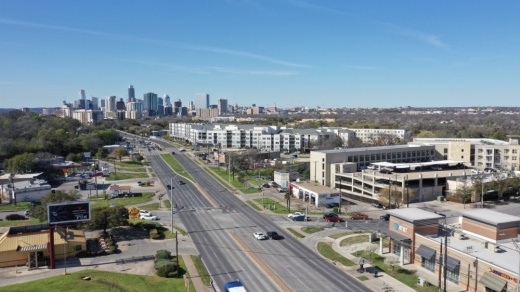Those trends are displayed in a new report from the Texas Real Estate Research Center at Texas A&M University. Researchers tracked residential and workforce flows between the five counties making up the Austin-Round Rock metropolitan area going back to 1990.
Their findings included data on the region's population swell since then, with Austin and Travis County staying at the center of that activity while their northern neighbor becomes more of a draw over time.
"The central city of Austin and its surrounding areas continue to grow, with growth largely concentrated to the north toward Williamson County. This means more urban-style development and jobs for Williamson County, which means many of its cities are no longer strictly bedroom communities of Austin-Round Rock," researchers wrote.
More recent data from the U.S. Census Bureau has shown that expansion around Central Texas is not slowing down, anchored by the rapidly growing Austin as well as some of the fastest-growing cities and counties anywhere in the nation up and down the I-35 corridor.
And as Austin nears 1 million residents, Williamson County cities to the north, such as Round Rock and Hutto as well as Pflugerville on the county border, are also growing and diversifying their populations.
The new analysis from A&M's real estate center reviews the longer-term basis for some of those trends as more links between the region's counties emerge.
Researchers found that just over 25% of workers living in Bastrop, Caldwell, Hays and Williamson counties were commuting into Travis County for their jobs in the mid-2010s, a jump from past decades when more workers were based only within Travis County. That shift has been headed by Williamson County, which had more than doubled its share of regional employment from 8% as of 1990 to around 17% by 2015. The county's population has also spiked relative to the region's. Residents there represented just 16% of the Austin metro area in the early 1990s, and growing interest in the area bumped that share to 24% in the last decade.
"The main relative shift is away from Travis County and toward Williamson County. While Travis County continues to grow in both employment and residents, Williamson County is growing at a faster rate," analysts wrote.
Research Economist Adam Perdue said a portion of Williamson County's rise is attributable to the growing number of semiconductor facilities in Austin and to its north. That development is one he said has attracted further interest in his research from local governments in the area.
In addition to its Northeast Austin campus, Samsung is also bringing a new $17 billion plant to Taylor; NXP Semiconductors is weighing an expansion of its local facilities in Austin; and an Applied Materials lab could be coming to Hutto. Toppan Photomasks was also considering development in the Round Rock area, although those plans may not be moving forward.
"Growth of Austin-area employment and population in Williamson County ... has continued and will be reinforced over the near term by the new chip plants coming online," Perdue said in an email.
Travis County residents have also been working within Travis County less over time. Around 97% of the county's residents were also employed there as of 1990, a figure that dipped several points to less than 92% during the past decade.
That trend is reversed to the north, where the majority of Williamson County residents now stay closer to home for work; in 1990, nearly 60% of them were employed in Travis County. "As the developed part of the region has moved northward, a growing number of Williamson County residents have found jobs in their own county," researchers said.
To the south, the less populous Bastrop, Caldwell and Hays counties have remained more insular or linked closely with Travis County only. Most residents there worked either in their own county or in Travis County, and in total still represent a much smaller share of the region's population and workforce despite their relatively rapid growth.
"The developed fringe of the Central Austin region has only recently expanded beyond the Hays County line along the southern corridor of I-35. It has yet to reach Bastrop or Caldwell counties, so residents there are likely still focusing on independent local job opportunities and commuting into Travis County," researchers wrote.
While areas to the south do not yet have workforces that are as strongly linked or independent as those to the north, researchers said the region's continued expansion should open up more population and employment opportunities—and deeper connections between those counties.
"I wouldn’t be surprised ... if development in South Austin and northern Hays County has been such that we will start to see [a] proportion of workers from Hays County working in Travis County grow a little faster for a while as Austin’s suburban fringe really starts to cross the border," Perdue said.
Perdue also noted that new opportunities for employees to work from home more frequently could contribute to the area's population spreading out even faster, eventually wrapping new cities and counties as far as San Antonio into the metro area.
"Driving on [I-35] in Hays and Comal counties really makes it feel like we are heading in that direction," he said.





